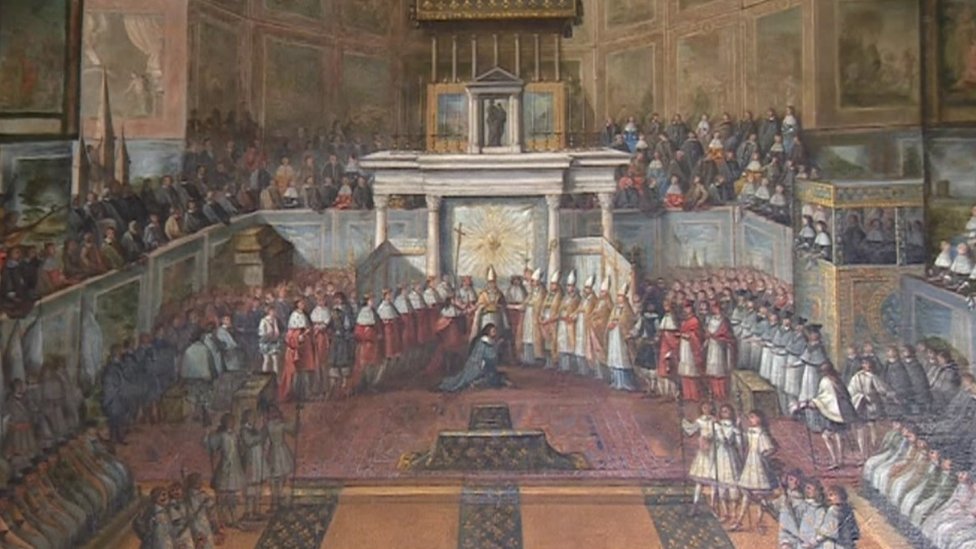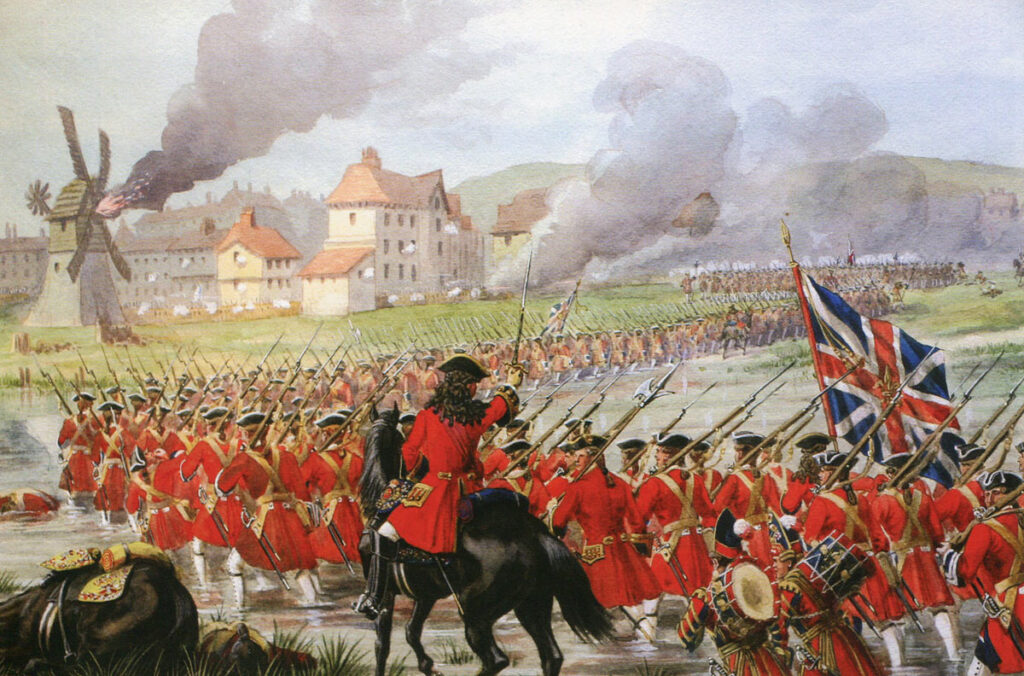During the 1660s, a new king would arrive on the block – a certain “Sun King” to be exact.
Louis XIV would ascend to the French throne in 1638 and would adopt the sun as his personal emblem, hence the nickname.
He would also later become the longest-ever reigning sovereign after ruling for 72 years and 110 days.
The Sun King was characterized by his insatiable desire to further the power and prestige of France in a manner seldom done before, and fortunately for him, the times would lend to such ambition.
In other words, the European scene, at the time of his coronation, was particularly favorable to a monarch determined to impose his will upon it.
Ready for Glory
To France’s south, Spain was still tiring itself in a futile attempt to reconquer Portugal.
Across the Channel, a restored English monarchy was still finding its feet after the death of Oliver Cromwell.
The English were also jealous of the prospering Dutch during this period, and Louis would fully seize the opportunities this presented.
To the east, the German Protestant princes were watching suspiciously for any Austrian attempt to improve its position, whilst Austria itself was facing an onslaught from the Muslim Ottomans.

The situation, as it was, was ripe for the French to take advantage of, and was therefore all too easy for the French to expand their borders.
And that’s what the Sun King would attempt to do.
By now the French diplomatic machine was in full motion – they were busily playing powers off one another, to the benefit of France alone.
They had also secured their geographical position through a treaty with the Swiss cantons.
But most importantly, Louis had removed his internal challengers, thus paving the way for him to become an absolute monarch.
This gave his loyal ministers the chance to overhaul the administration whilst also building up the navy and army to ready the country for the king’s pursuit of glory.
Louis Invades Southern Netherlands
It was at this point in 1665 that relations soured between the Dutch and English, quickly leading to the Second Anglo-Dutch War.
The French pledged its support for the Dutch Republic and opportunistically readied itself for an invasion of the Southern Netherlands which was owned by a weakened Spain.
So it was unsurprising after all their preparation that when they did invade in 1667, town after town fell to France.
But fearing French ambitions, the Dutch and English quickly signed a peace treaty at Breda, seeking to limit Louis’ gains.
Indeed, these rapid diplomatic shifts would become a recurring feature throughout this period.
And it worked, a little too well perhaps, because it also left the Sun King thirsting for revenge on the Dutch who were supposed to be his ally.
So, aiming to prepare for his revenge, over the next few years France used secret diplomacy to seduce English and Sweden, whilst soothing the fears of German states and Austria who were balking at the prospect of French expansion.
And by 1672, the French, aided by the English at sea, were ready to strike at the Dutch.
Target: The Dutch
Interestingly, it was the English who struck first, but their appalling performance during the Third Anglo-Dutch War needs little mention here.
What matters though was that the war was so unpopular in England that they were forced to pull out by 1674.
Unfortunately for the Sun King, this would have international repercussions for France, who were in the middle of a land invasion of the Dutch Republic by this point.
This was especially because it highlighted the mounting alarm around Louis’ designs that was spreading throughout Europe.
And so, within another year, Dutch subsidies had quickly brought together a coalition of German states, Brandenburg, Denmark, Spain, and Habsburg Austria.
Yet this alliance was not going to be enough to overwhelm the French.
The fact of the matter is that all had smallish armies, and each had other distractions to deal with as well, meaning that the core of the anti-French alliance was still the Dutch military.

But having the various foes surrounding the French was enough to make sure the Sun King could make no dramatic gains at land.
Nor were their gains made at sea either.
Whilst the Mediterranean was securely controlled by the French, the Baltic was no less securely controlled by the coalition.
Locked in a stalemate, and with both the Dutch and French economies badly hurting, peace was sought by both powers.
This culminated in the Nijmegen treaties of 1678-79 which ended the Franco-Dutch War.
Unwavering Desire
By now it’s probably not shocking to find out these treaties did not dull the Sun King’s desire to become ‘the arbiter of Europe’.
The fact that he continued to maintain an army of 200,000 attested to this, nor did it help allay the fears of his neighbors either.
But this didn’t mean that war was imminent for now at least.
You see, Dutch merchants, who had an outsized influence over their government, unsurprisingly preferred trading in peacetime.
And the Germans and English were too dependent on Paris for subsidies to wage any kind of war, whilst the Habsburgs were occupied by the Ottoman threat to their eastern flank.
So when the Spanish tried to protect its Luxembourg territories from the French in 1683, they were inevitably forced to fight alone and suffer defeat.
From 1685, however, the situation steadily turned against France.
Their persecution of the Huguenots had shocked protestant Europe.
And 2 years later, the Austrians had firmly driven the Ottomans away from Vienna, meaning they could turn some of their attention towards the West.
And it was also during this time that the Dutch leader, William of Orange, was given the English throne, thus paving the way for an Anglo-Dutch alliance that would survive for the next few decades.
The Sun King was getting pretty nervous.
Or perhaps not.
In 1688, Louis decided to invade Germany, which unsurprisingly provoked his continental neighbors into joining the war against him.
Consequently, by the end of 1689, France stood against the Dutch Republic, England, Habsburg Austria, Spain, Savoy, and the major German states.
As before though, this coalition was not as alarming as it seemed; the core consisted of the Anglo-Dutch forces whilst the other allies contributed comparatively smaller armies.
Yet despite being a motley grouping in some respects, the coalition had enough determination, resources, and military might to counter the French threat.
Thus the Nine Years War would start off with France seeking to quickly destroy a major ally and quickly end the war.
But as the name of the war suggests, they weren’t exactly successful in that respect.
Their hope was that by destroying one important member, the rest of the coalition would soon disintegrate.
But the Sun King couldn’t choose who he wanted to destroy first.
After dithering for three years, he decided to launch an invasion against England in 1692, only to quickly find out his invasion force had been thoroughly defeated by the English and Dutch.
From this point on the war would become a slow, grueling affair focusing on a mutually ruinous war against trade.
This would involve the French government employing privateers to prey on Anglo-Dutch merchant shipping.
And the allies would, for their part, attempt to institute a commercial blockade on France by using their warships to prevent any merchant ships from getting through to France.
On a side note, this new form of warfare during this period led to the rise of pirates such as Blackbeard.
When the governments employed people to raid the ships of other countries, they were known as privateers.
But when these privateers decided to go it out alone, they were called pirates.
Anyway, this ruinous trade war only increased the economic burdens of the war.
The war was unpopular with both merchants and peasants, the latter of whom were already suffering due to successive bad harvests.
Nor was there wasn’t any progress on land either, even though both sides were maintaining 250,000 troops which only contributed to the horrendous costs of war.
Thus, both William and Louis had by now enough cause to compromise.
The subsequent Treaty of Ryswick (1697), despite letting Louis keep some of his earlier gains, made little change to the status quo.
But the effects of the Nine Years War (1689-97) were definitely not small.
French land ambitions had been blunted, and its naval power eroded.
England had successfully strengthened its economic base and built up its army and navy.
And albeit at great cost, the political plurality of Europe had been reasserted.
So, given the weariness incurred after nine long years of war, you’d assume another war would not be likely, right?
No.
The Sun King had other plans.
Final War
When in 1700 the Spanish throne was offered to his grandson, Louis XIV seized the opportunity to swiftly occupy the southern Netherlands (modern-day Belgium) on behalf of his grandson.
Additionally, he managed to secure exclusive trade concessions for the French in Spanish America.
News of these moves sufficiently provoked the British and Dutch into forming a coalition with Austria in 1701, thereby starting the War of the Spanish Succession.
And yet again, the balance of the forces suggested each side could seriously hurt, but not overwhelm the other.
The Spanish, now led by Louis’s grandson Philip V, formed an alliance with France, which worked well in many areas.
French finances, for example, were helped immensely by Spanish silver imported from the New World.
And the size of the French military increased to such an extent that at one point it actually neared half a million men under its payroll.
Additionally, the British government was to commit to this continental war like it never had done before, using its large resources used to subsidize its German allies, and deploying its powerful Royal navy and a 110,000-strong army.
The Dutch and the Austrians, each numbering around 100,000 joined the fray also, attempting to frustrate Louis’ wish to impose his wishes upon Europe.
But nor did it mean this Grand Alliance could impose its wishes upon France, or even upon Spain for that matter.
But outside those kingdoms, events did turn in favor of the allies.

At Blenheim (1704), Ramillies (1706), and Oudenarde (1708), Franch attempts at expansion were brutally halted by the Anglo-Dutch forces.
And at sea, the French and Spanish were overcome by the Royal Navy, along with its Dutch and Portuguese equivalents gaining supremacy.
This was especially the case after the seizure of Gibraltar (1704), which allowed the Royal Navy the ability to control what entered and exited the Mediterranean.
This also had the effect of splitting the fleets of the French and the Spanish, who now found themselves unable to freely move along their coasts.
The Royal Navy also helped during the capture of Minorca and Sardinia and covered Savoy and the Italian coasts from French attack.
But despite this maritime superiority, the ability of the allies to wound but not kill the French and Spanish on land was still too obvious.
By 1709, the allied invasion army was retreating after a brief occupation of Madrid, after finding themselves unable to hold their ground in the face of a Spanish counterassault.
And in northern France the Allies could not replicate their success at Blenheim, meaning that the war only got more tedious and expensive.
And not only did a new government eager for peace enter office in Britain, but the Allied candidate for the Spanish throne, Archduke Charles, unexpectedly became the Austrian Emperor, which dried up any enthusiasm for war to continue.
A union, you see, between Spain and Austria was as unwelcome as one between France and Spain.
Consequently, in 1712, Britain decided to unilaterally defect from war, and soon after the Dutch and the Austrians followed suit.
Little to Show Except Debt
The peace that ended the War of the Spanish Succession was fixed in the treaties of Utrecht (1713) and Radstadt (1714).
And by then there was little doubt the greatest beneficiary of the war was Britain.
From this war alone, Britain gained Gibraltar, Minorca, Nova Scotia, Newfoundland, and the Hudson Bay; meanwhile also gaining trade concessions in Spanish America.
The settlements also brought a satisfying reinforcement to the equilibrium within Europe, meaning that the principal aim of the war had been achieved admirably by the Grand Alliance.
And although Philp V stayed as Spanish king, the French and Spanish monarchies would remain forever separated.
Despite Austria’s failure to capture Spain, it managed to win the southern Netherlands, Milan, Naples, and Sardinia.
Even better for Britain at least, although Dutch independence had been guaranteed, Dutch naval and commercial power went into decline.
Nevertheless, the Sun King Louis XIV had been finally checked in his dynastic and territorial aims, whilst France was left humbled by the ridiculous costs of war which had increased government debts by 600%.
At land, the balance was maintained, whilst at sea the British would continue to reign supreme for the next 200 years.
Footnotes & Further Reading
Kennedy, Paul M. The Rise and Fall of the Great Powers: Economic Change and Military Conflict from 1500-2000. London: William Collins, 2017.


